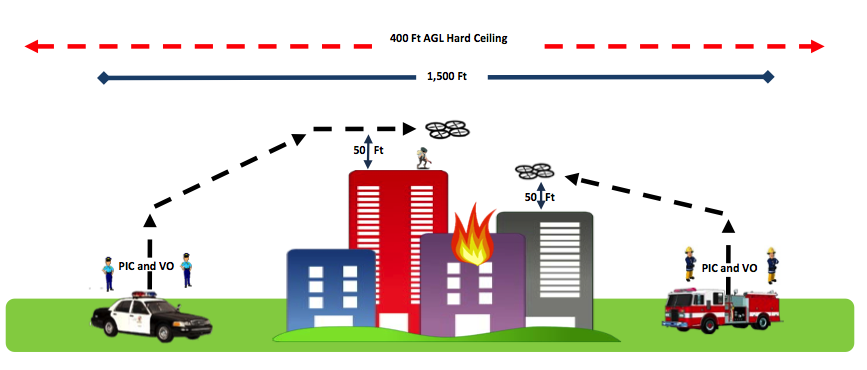The way in which drones can serve as a force multiplier to literally save lives have been well documented. Whether it’s to increase firefighter safety, locate a missing person or utilize a drone as a first responder, these results have compelled public safety departments of all sizes and types to ask what kind of drone is going to provide these benefits to their communities.
Unfortunately, the way many departments want to utilize drone technology in emergency situations would require them to operate beyond visual line of sight (BVLOS), which falls outside of the Part 91 Certificate of Authorization under which most of them are operating their drone. First responders and other organizations responding to emergency situations that want to operate BVLOS have had to seek approval through the Special Governmental Interest (SGI) process, which is done very well by the SOSC but may not provide the immediate approval needed in very dangerous missions where lives are in the balance and every second counts.
To address this challenge, public safety advocates worked with the FAA to create the Tactical Beyond Visual Line of Sight (TBVLOS) waiver process. This waiver is the culmination of over nine months of collaboration with York County Fire and Life Safety, Chula Vista Police Department, San Diego IPP, Pearland Police Department, SKYDIO and DRONERESPONDERS. The FAA introduced TBVLOS to allow public safety responders to more easily operate their drones BVLOS in emergency situations to best assess the operational environment.
This collaborative effort of public safety stakeholders reinforced that safety would remain the priority. The FAA came to better understand how the risk mitigation that is their priority would fall in line with the risks that public safety officials are required to take on an everyday basis.
Charles Werner, retired Charlottesville, Virginia fire chief and DRONERESPONDERS Director stated, “The FAA does its best to prevent any risk that impacts the safety of the National Airspace and their number one priority is to have the safest airspace in the world. We were determined not to get in the way of enabling that. By defining our needs to fly BVLOS within a limited space to get critical info and keep the remote pilot and visual observer out of harm’s way while mitigating both air and ground risks, we were able to prove to them that the safety of the airspace would remain of the utmost importance during these types of operations.”
Upon receipt of 91.113 waiver approval and approved COA update, the FAA will authorize in advance, the revised COA which includes the 14 CFR 91.113(b) waiver that will allow temporary UAS TBVLOS operations within specific conditions and requirements. These conditions have been established to ensure that the safety of the National Airspace remains a priority. It includes requirements such as ensuring that the First Responder is already flying under a valid Part 91 Certificate of Authorization (COA), that TBVLOS is only to be used in extreme emergency situations to safeguard human life, and that the UAS must fly within 50 feet above the highest obstacle (not to exceed 400 feet AGL or LAANC Grid ceilings), remain within 1500 feet of the PIC. These are just a few of the conditions that the TVBLOS waiver establishes, but they illustrate the many ways in which safety is being prioritized for everyone directly and indirectly involved.
“The 1,500 feet lateral distance is reasonable to maintain the signal link between the controller and the aircraft,” Werner told Commercial UAV News. “That distance would also provide for full operational reach for most any big city block or to fly over most buildings to the other side. Altogether, this provides full 360-degree operational visibility for public safety without being exposed to danger.”
Applying for a TBVLOS waiver is a two-step process. First, applicants need to send their initial requests for the TBVLOS airspace authorization to the FAA, which should include the concept of operations and their existing Part 91 COA number. Once the concept of operations is approved, applicants will be instructed to submit through the COA Application Process system for their waiver. DRONERESPONDERS has put together a TBVLOS waiver request template to guide public safety officials though this submission process. The template is available as a free resource on the DRONERESPONDER site.
For years now, BVLOS operations that can be more easily enabled have been positioned as a tipping point for drone technology as a whole. The TBVLOS waiver is creating a path to doing so for public safety officials in the present while also providing a potential framework for these types of easily-enabled BVLOS operations in other industries in the future.
Visit the DRONERESPONDERS site to download their TVBLOS waiver resource for free.















Comments